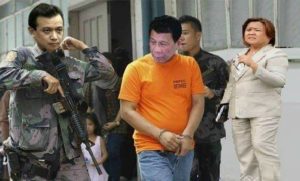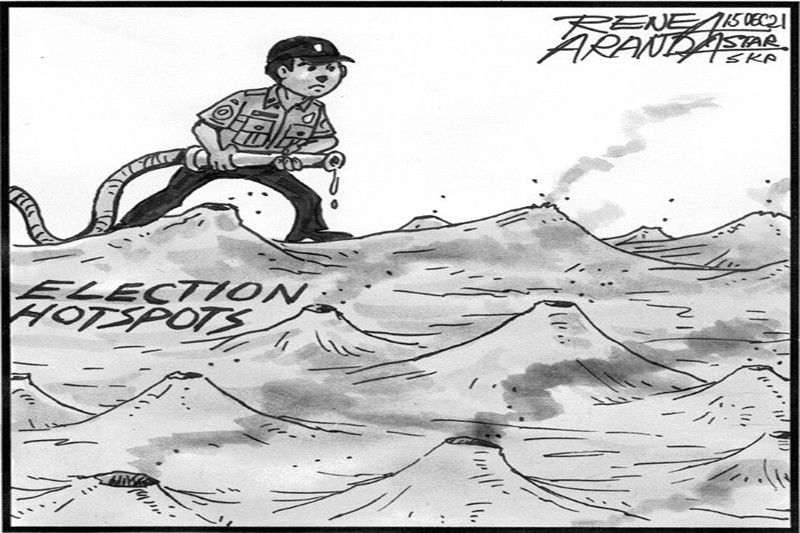EDITORIALS & CARTOONS: Hotspots for violence
.

.

.


.
Ads by: Memento Maxima Digital Marketing
@[email protected]
SPACE RESERVE FOR ADVERTISEMENT
EDITORIAL -Hotspots for violence

Over 500 areas nationwide have been identified as hotspots in the 2022 general elections, according to the Philippine National Police. Each hotspot, identified by PNP intelligence officers, is color-coded based on the potential for poll violence.
The PNP said 488 municipalities and 58 cities have been initially included in the list of areas that will be placed under closer monitoring for election-related violent incidents.
Areas coded green are the most peaceful while those under the red list are the worst, which might call for control by the Commission on Elections. This means the Comelec will have supervision over local officials in the red area.
Identification of hotspots was always done in previous elections, but violence continued, with deadly attacks being launched as soon as persons declared their intent to seek elective office. This is again being seen as the country prepares for the general elections in May 2022. Even before the filing of certificates of candidacy this year, several potential aspirants have been murdered, with probers pointing to politics as the likeliest motive.
The attacks are facilitated by the ease of obtaining unlicensed guns in this country and the belief that weak law enforcement will allow the perpetrators to get away with their crime. The belief is strongest among entrenched politicians who think they have control over the criminal justice system in their turfs.
An election gun ban will take effect beginning Jan. 9, but enforcement of such bans has always been tricky especially in conflict zones where rebels and extremist bandits operate.
The PNP said many of the areas in the so-called red list of hotspots are in the Bangsamoro Autonomous Region in Muslim Mindanao. The Moro Islamic Liberation Front, which has won an extension of its supervision over BARMM, can show that the peace effort is working, by clamping down on election violence in the region.
Elsewhere in the country, law enforcers need to intensify efforts to prevent election violence. The PNP must prevent incumbent officials from using police and civilian force multipliers as private armies. Candidates who are supported by armed groups must also be prevented from using force to harass rivals and their supporters. No one must be allowed to use violence to undermine the vote.pat paigtingin ng PNP

EDITORYAL – Marami pang tahanan ang balot ng kadiliman



.
Ads by: Memento Maxima Digital Marketing
@[email protected]
SPACE RESERVE FOR ADVERTISEMENT
.
The Straits Times says
Vital to prepare for Omicron wave now

It has not taken long for the Omicron variant of the coronavirus – which has been detected in over 60 countries, mainly in Africa and Europe – to become the new global face of the pandemic and make its way to Singapore. There have been 16 cases picked up here already – primarily imported cases. Given that evidence suggests that Omicron has a higher transmissibility rate than variants that are circulating currently, and even though community transmissions have not been detected here, it is essential to be prepared for any eventuality. A slew of measures announced yesterday is aimed precisely at planning for an upsurge in cases – but without panicking.
The Government has acted with due speed in the awareness that the variant could result in a bigger wave of Covid-19 cases than the one caused by the Delta variant. Key elements of Singapore’s response are the plans to increase intensive care unit (ICU) capacity to 500 beds, and to study whether infrastructure upgrading needs to be carried out in public hospitals to support this. ICU beds lie at the heart of the many layers of medical care available to the sick. Any possibility of ICU capacity being overwhelmed needs to be planned for. Other parts of the healthcare system, too, need to be prepared to deal with a possible upsurge. Hence the emphasis on having contingency plans to also ramp up hospital and Covid-19 Treatment Facility capacities, in addition to the plans for ICUs. Singaporeans know how successive, and swift changes to health, social interaction and travel protocols have enabled the country to weather a crisis that has waxed and waned for the better part of two years.













